Dissecting Nike’s social media strategy: Lessons in influencer marketing and driving culture

Table of Contents
Nike’s social media strategy isn’t just about selling products—it’s about chasing the impossible and shaping global culture. The brand’s historic legacy built on athlete partnerships has made Nike the blueprint for social media success in any industry.
Their recent Breaking4 campaign is the latest example of a global movement that illustrates how belief-driven storytelling can transform brand and culture. And it’s just one in a long line of historic athlete partnerships that have consistently redefined what’s possible in sports and marketing.
We’ll unpack Nike’s social media marketing, from their multi-network approach and compelling storytelling to their strong brand identity and community. We’ll also examine how their groundbreaking partnerships with sports legends and influencers have set new standards for the industry.
How does Nike use social media?
Nike’s social media is focused on inspiring its audience. They don’t just post; they curate an experience, building a brand identity that is as much about aspiration as it is about their products.
Let’s dig into the core elements.
Multi-network presence
Nike understands that a diverse audience requires a diverse presence. Nike’s social media spans all major networks, including Instagram, Facebook, X (Twitter), TikTok and YouTube.
They leverage each network’s unique features and audience demographics to deliver personalized content. For instance, Instagram is a hub for visually stunning imagery and short, impactful videos, while YouTube hosts longer-form documentaries and behind-the-scenes content. TikTok is used for trends and quick, engaging clips, often featuring younger athletes or user-generated content.
Nike also embraces niche communities, creating segmented accounts for sub-brands, sports, regions and specific demographics (e.g. @nikerunning).
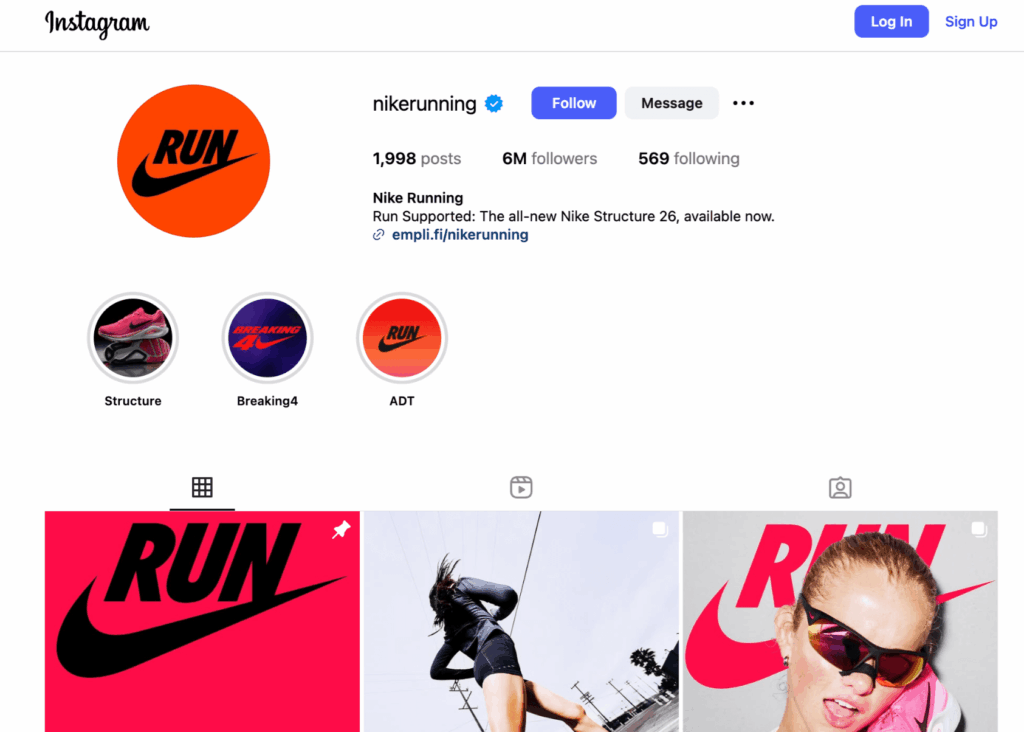
This multi-network approach ensures that Nike’s message reaches its target audience wherever they are, in the format they prefer.
Strong brand identity
Nike is an iconic brand for a reason. The Swoosh, “Just Do It” and Nike’s signature tone—confident, empowering and gently rebellious—are unmistakable. What keeps it that way is consistency. Their identity is consistently reinforced across channels through a unified brand voice and captivating social creative.
High-quality visuals, often featuring athletes in action, create a premium and aspirational feel that aligns with the brand’s position as an industry leader.
With this strong and consistent brand identity, they’re able to maintain trust, loyalty and secure their spot as an iconic brand.
Emotional storytelling
At the heart of Nike’s social media marketing success is inspiration. Every campaign, from iconic athlete journeys to micro-moments with emerging stars, leans heavily on emotional narrative.
Their social content is designed to evoke strong emotions—inspiration, determination, resilience. Nike’s social media campaigns often follow universal themes of ambition, adversity, hope and community—subjects that create emotional buy-in and shared purpose.
The focus is rarely on the technical specifications of their products but rather on the feeling of wearing it, the pursuit it enables and the greatness it helps unlock for athletes. This fosters a deeper connection, moving beyond a transactional relationship to an emotional bond.
Building community
They don’t just interact. They create arenas for dialogue and co-creation, actively building community among fans.
Nike encourages user-generated content (UGC) through hashtags like #mercurial, transforming customers into brand ambassadors. This creates an endless supply of authentic content while making fans feel like they are part of something bigger—a global movement of athletes and dreamers.
Nike’s social media presence also taps into their community’s interests, participating in popular sporting events where and when their audience wants to see it. During the US Open, Nike focused their X channel on updates and quick previews, while on TikTok they posted interviews with tennis stars like Carlos Alcaraz. According to NewsWhip by Sprout Social, this X post celebrating Alcaraz’s win is one of their top performing posts on the network since June 2025. While it simply includes an image and tagline-like message, it generated over 40K interactions.
Engaging directly with your audience and their interests fosters a sense of belonging and loyalty among customers, encouraging interactions that help spread the word and drive sales.
Balancing activism and marketing
Nike has consistently shown a willingness to engage with social and cultural issues, often aligning its marketing with broader societal conversations. And this is what their audience wants.
According to The Sprout Social Index™, 93% of consumers agree it’s important for brands to keep up with online culture and combat misinformation more than they are today.
Campaigns featuring athletes like Colin Kaepernick in “Dream Crazy” or addressing gender equality are integrated into content, not tacked on. While sometimes polarizing, its always purposeful.
Each social campaign is closely tied to Nike’s core values, aligning brand activism with audience expectation. This balancing act of activism and marketing showcases Nike’s understanding that today’s consumers expect brands to have a deep understanding of cultural nuances as it pertains to their interests.
Leveraging influencers
Influencer marketing is a cornerstone of Nike’s social media strategy. Their influencer partnerships run the gamut, from the world’s greatest athletes to sneaker heads and fashion creators.
Close relationships with top athletes like LeBron James and Serena Williams drive trust and aspiration. While everyday athletes and sneakerheads expand the brand narrative, making it universally relevant.
Regardless of their fame or follower size, their collaborations infuse authenticity and extend their reach, like in this Instagram post with pro golfer Scottie Scheffler that earned over 460K interactions. In it, Nike subtly includes their gear and logo alongside a bigger message about Scheffler’s family values and recent major win.
These partnerships go beyond mere endorsements; they become symbiotic relationships where the influencer’s personal journey and achievements are intricately linked to the Nike brand.
Nike social media campaigns with enduring influence
Nike’s social media campaigns are often anchored by the concept of “chasing the impossible” and have consistently set the pace for the industry. Let’s take a deeper look at a few standout athlete partnerships and what made them win.
Breaking4: Faith Kipyegon’s quest
Nike partnered with Faith Kipyegon, the world record holder in the mile and 1,500-meter run, to chronicle her attempt to become the first woman to break the sub-four-minute mile.
The campaign transformed Kipyegon’s quest into a global narrative designed to live on social. They streamed it live across YouTube, Instagram and TikTok, offering behind-the-scenes content leading up to the attempt. Interviews with Faith and her coaches, explanations of the pacer strategy and formation, and an in-depth deep dive on everything Nike did to prepare Faith for this moment—were all optimized for discovery and sharing to build anticipation.
According to Sprout Social Listening data, the campaign generated an estimated $5.3 million in earned media value and nearly a billion impressions, with 93% positive sentiment. During a recent webinar, Sprout also shared that many of the conversations revolved around the Nike products featured, especially the sports bra. So, people went to social to find out more—from Nike’s comments sections to users making their own videos reviewing Nike products. All of this buzz underscored Nike’s return to performance-level gear.
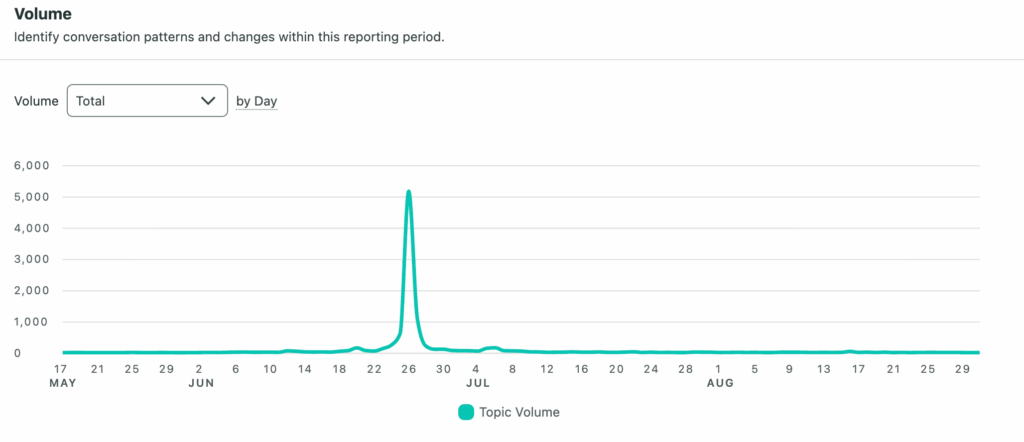
Though Kipyegon didn’t break the four-minute mile (running 4:06.42), the pursuit, combined with Nike’s support, solidified the campaign’s success in brand storytelling and engagement (almost 1M engagements). It also laid the groundwork for future content, maintaining the message and partnership.
Sue Bird, Megan Rapinoe and Togethxr: Championing inclusivity
Nike’s partnership with WNBA star Sue Bird and USWNT captain Megan Rapinoe, through media and commerce company Togethxr, highlights the brand’s deep commitment to representation, inclusivity and cultural leadership.
Co-founded by Bird, Alex Morgan, Simone Manuel and Chloe Kim, Togethxr is rooted in lifestyle and youth culture, where representation and equality are the norm. And with Nike, they are creating content and products that support this ethos.
Nike created content featuring Bird, Rapinoe and other icons, providing a platform for women athletes and underrepresented voices to move culture. Their social content with these athletes and the Togethxr brand often focuses on themes of collective empowerment, challenging norms and celebrating diverse narratives, reinforcing Nike’s role as a progressive force in the industry.
This collaboration has also been a force of online engagement, with the campaign receiving 16,153,727 potential impressions and achieving 93% positive sentiment thus far in 2025, per Sprout Listening data.

Kobe Bryant and #MambaDay
Nike’s tribute to Kobe Bryant with the #MambaDay campaign is a poignant example of leveraging social media for emotional storytelling and community activation. The campaign, initially launched for his final NBA game, mobilized over 200 athletes and millions of fans worldwide to celebrate his iconic career and “Mamba Mentality.”
Key to its digital success was the strategic use of #MambaDay and other similar hashtags, expanding its meaning beyond a tribute. The hashtag transformed every post into a branded message, effectively turning millions of fans into Nike brand ambassadors.
The campaign generated viral conversations, with fans, celebrities and even other brands and sport federations participating. According to NewsWhip by Sprout Social, Nike’s Instagram account saw a significant increase in interactions (over 776K) when they posted this video linking the Mamba Mentality to FC Barcelona.
The 2025 Mamba Day campaign paired with the launch of the new Kobe 8 Protro generated 2,258,491 potential impressions, 67,791 engagements and 96% positive sentiment, according to Sprout Listening data.
The campaign’s success proves that Nike can navigate moments of intense emotion with authenticity and respect, solidifying its bond with athletes and fans alike.
Air Jordan: A legacy amplified
The partnership between Nike and Michael Jordan, initiated in 1984, set the gold standard for athlete-driven branding and built an empire. The Air Jordan line is a cultural icon that redefined the intersection of sports, fashion and marketing.
This phenomenon has turned into a legacy. Dedicated Air Jordan accounts on networks like Instagram and X maintain a constant dialogue with a passionate fanbase and keep the brand connected.
Influencer collaborations with contemporary athletes, musicians and streetwear personalities keep the brand relevant for new generations.
Community-driven content, featuring fans unboxing new merchandise or styling their gear, fosters a strong sense of belonging and nostalgia. Sneaker drops are transformed into global events, fueled by pre-hype teasers and social media activations.
They even revived the legendary Air Jordan 1 “Banned” story in celebration of the 40th anniversary, reigniting fans’ passion through viral storytelling.
Sprout Listening reveals that the Jordan brand has garnered 4,718,953,903 potential impressions and 3,974,164 engagements so far in 2025. While the 40th anniversary activations have exploded to 89,644,981 potential impressions, 58,035 engagements and 87% positive sentiment between May 1–July 31, 2025.
Analysis of Nike’s social media presence
Nike’s main accounts boast an enormous following across all major networks:
- Instagram: +300M followers
- Facebook: 39M followers
- X: 10.1M followers
- TikTok: 7.6M followers
- YouTube: 2.17M subscribers
- Pinterest: 1.1M followers
According to Sprout Listening data, Nike dominates social media with a 56.7% share of voice over competitors through their broad platform presence and specialized handles for diverse brands and audiences.
With NewsWhip by Sprout Social, we’re able to see that since June 2025, their spikes in interactions across Instagram and X have often been associated with content aligned to upcoming or live popular sporting events, such as tennis opens, golf majors and football matches.


Sprout Social’s sentiment analysis reveals that Nike generally maintains a positive brand perception, with 74% overall positive sentiment in 2025 so far. Even when a campaign sparks controversy, the overall sentiment remains strong, often due to a surge in positive sentiment from segments of their audience that align with the brand’s stance. Nike understands its core audience and is willing to take calculated risks that deepen loyalty among those who share their values.
The sheer volume of user-generated content associated with Nike, driven by their community-building efforts and hashtag campaigns, speaks volumes about their engagement. Millions of posts featuring Nike products, athletic achievements and personal stories contribute to a perpetual organic buzz around the brand. This UGC acts as authentic social proof, further bolstering Nike’s credibility and reach.
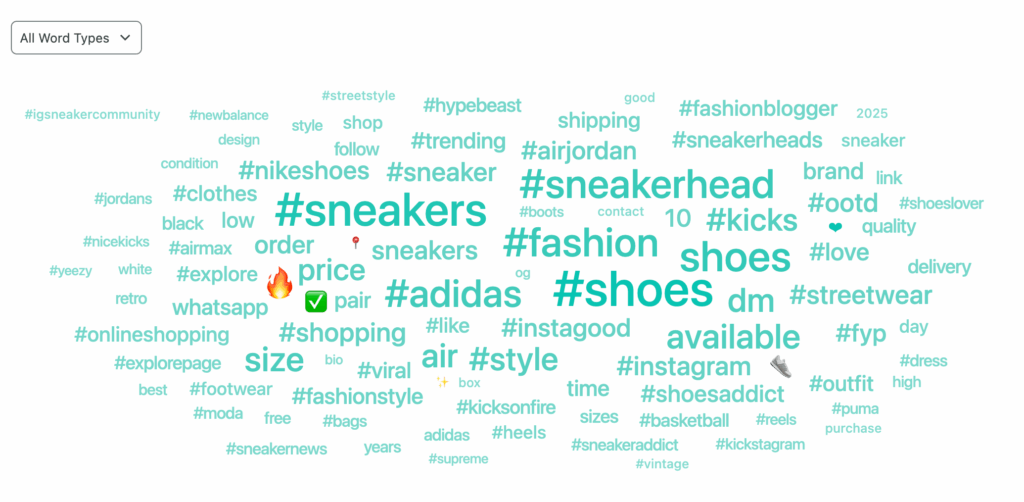
What marketers can learn from Nike’s social media marketing
Nike’s success stems from its bold approach to social media and marketing. While not every brand can adopt such boldness, the key takeaway is to identify the cultural intersection between your audience and brand, and then fully leverage that connection.
But how do you do that? Here are some key lessons to follow:
Network-specific content
Nike doesn’t just repurpose content. They understand the nuances of each network and tailor their content accordingly. Short, dynamic videos for TikTok, high-quality inspirational imagery for Instagram, long-form documentaries for YouTube and news-driven updates for X. Marketers should invest in understanding their audience on each network and creating content that resonates natively with that environment.
Community and UGC
Nike excels at making its audience feel like part of something larger. Their active community presence enhances trust and drives organic engagement and sales.
Brands should encourage user-generated content, create compelling hashtags and foster online communities where customers can connect with each other and the brand. This provides authentic content and also builds powerful brand advocacy.
Authenticity and values
Nike’s willingness to stand for something, even when controversial, has cemented its authenticity. Brands need to identify their core values and authentically integrate them into their social media presence. However, this must be genuine; performative activism will likely backfire.
Make your brand a symbol, not just a seller. Consistent values-driven messaging builds long-term loyalty, so prioritize personalized stories that will connect with your audience.
Data-driven creativity
While Nike’s campaigns are highly creative, they are also informed by data. Social listening and analytics provide insights into audience sentiment, trending topics and campaign performance.
By using these insights, Nike tailors its campaigns to specific demographics and trends, ensuring the highest level of engagement and relevance. This same approach will enable your brand to lead in a competitive market and meet the ever-changing needs of your followers.
Leverage social media management tools, like Sprout, to unify your social data across networks, combining a holistic view with deeper analytics to understand your audience better, identify opportunities and refine your content strategies for maximum impact.
Partnering with influencers of all sizes
While Nike partners with global superstars, their strategy extends to athletes, celebrities and everyday fitness enthusiasts who champion their products and ethos.
Brands should consider collaborating with micro-influencers and nano-influencers who have highly engaged niche audiences. Authenticity, alignment with brand values and quality engagement are more important than sheer follower count. Plus, developing long-term relationships with influencers can yield far greater returns than one-off endorsements.
Sprout Social Influencer Marketing enables end-to-end campaign management, from finding topically relevant influencers with AI-powered search to tracking campaign performance.
What’s next for Nike’s social media strategy
Nike’s social media strategy continues to set the industry pace. Their willingness to chase the impossible—backed by science, storytelling and universal themes—makes them a cultural catalyst.
Looking ahead, Nike will likely continue to innovate in the digital space.
- Expect bolder moonshot campaigns expanding into new sports, geographies and digital platforms.
- Look for more immersive content (e.g., AR/VR experiences) with technologies like augmented reality (AR) and virtual reality (VR) to create more personalized and interactive consumer experiences.
- Nike will undoubtedly continue to invest in athlete and fan storytelling alongside leadership in cultural conversations.
- As competition heats up from brands like Hoka and Lululemon, they’ll double down on what works: using social media to inspire and break down barriers.
While the networks and tools may change, the blueprint of relentless curiosity, community-building and value-driven storytelling is timeless. Start by believing your brand can set the pace—and then prove it.
Get started by downloading The 2025 Sprout Social Index to find out what consumers want most and where the future of social is heading.

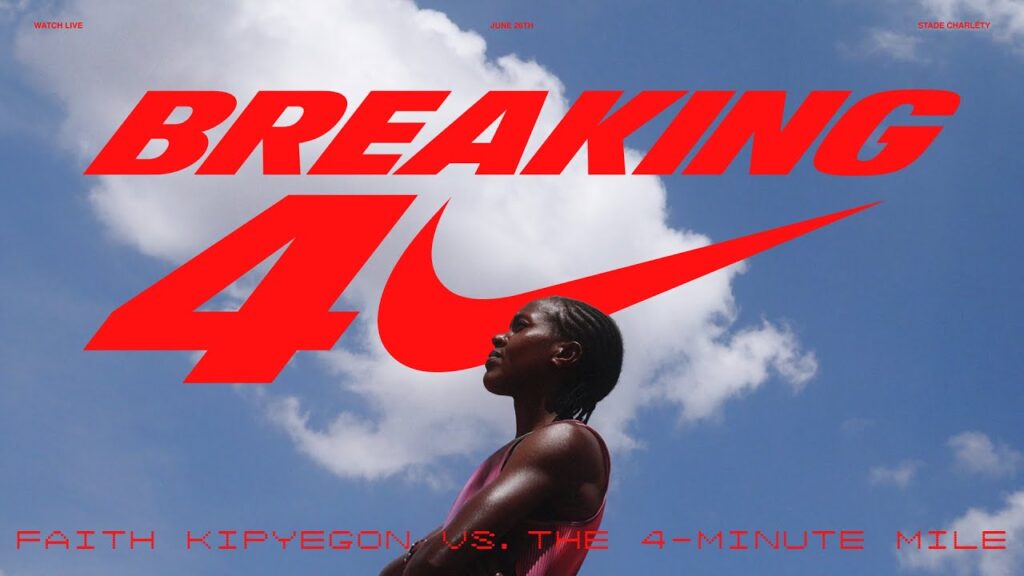
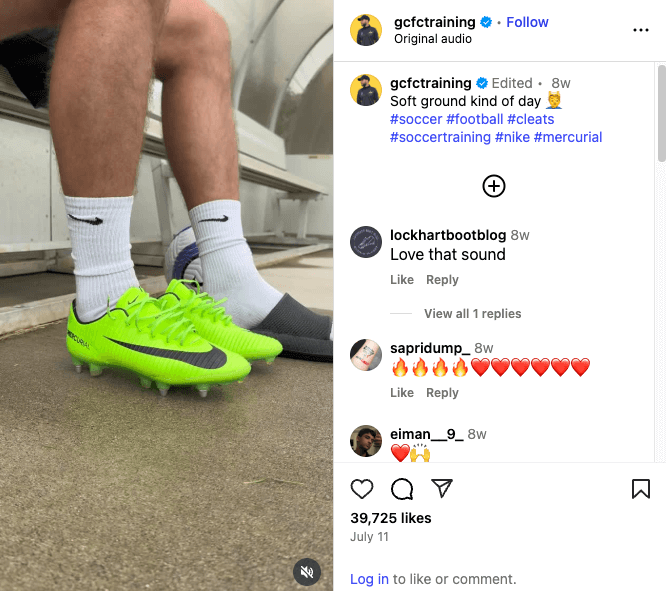
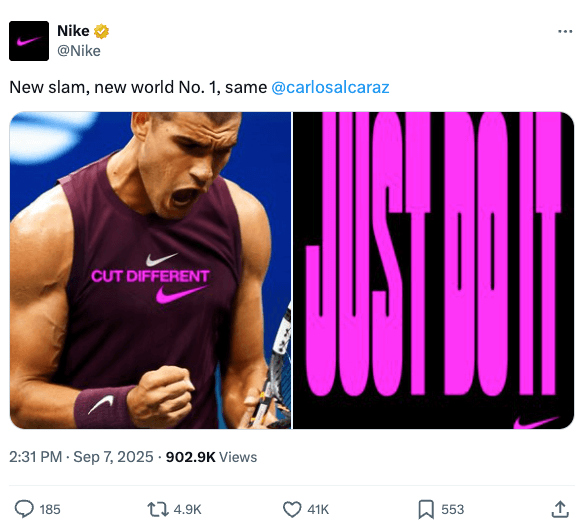
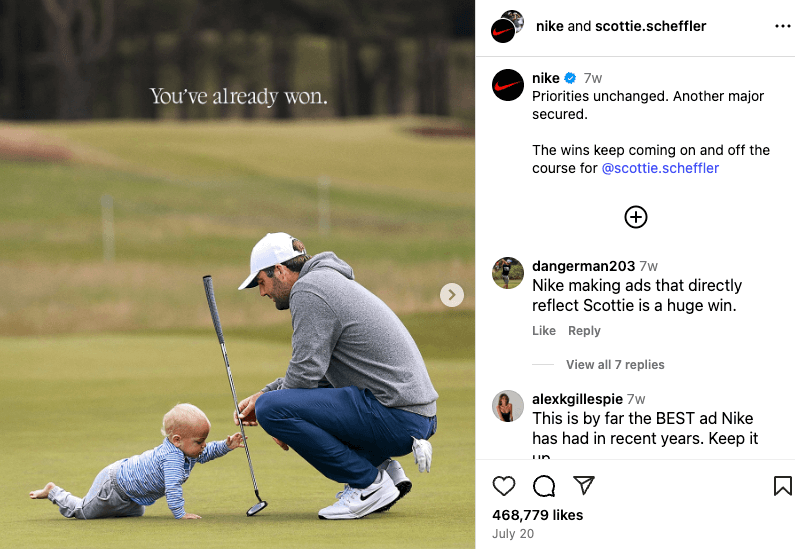

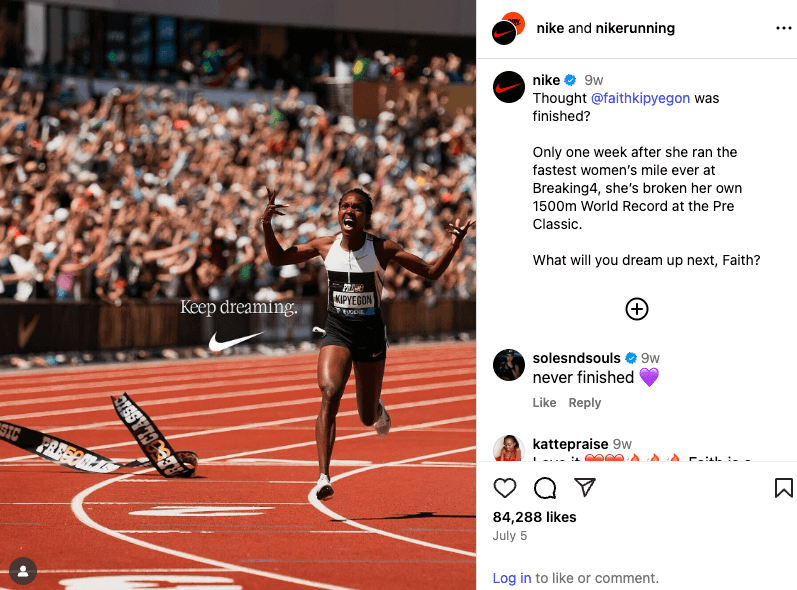


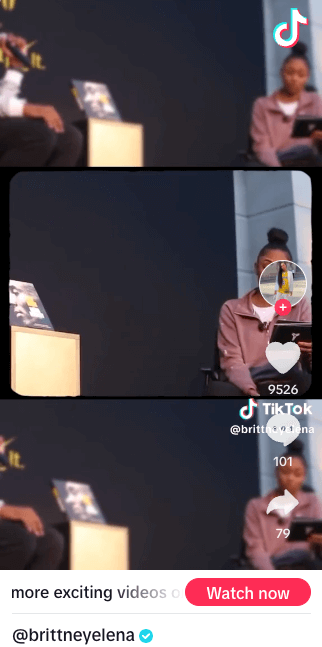

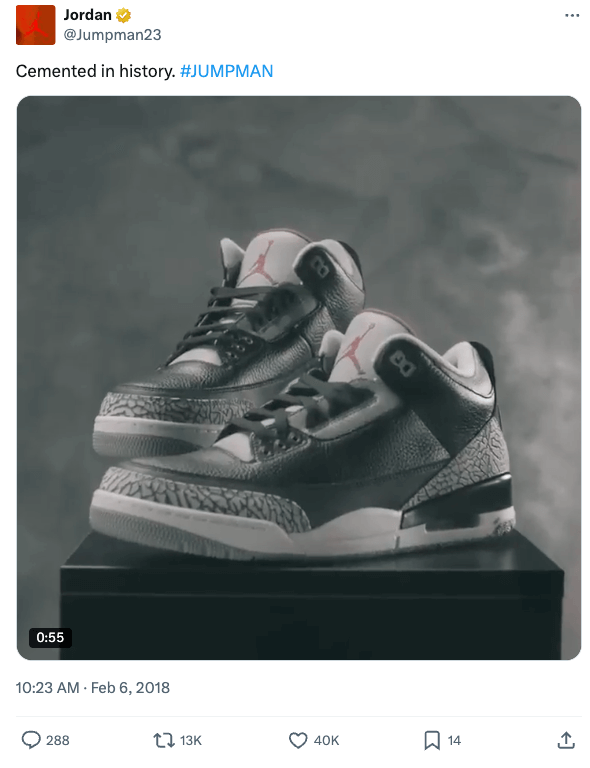
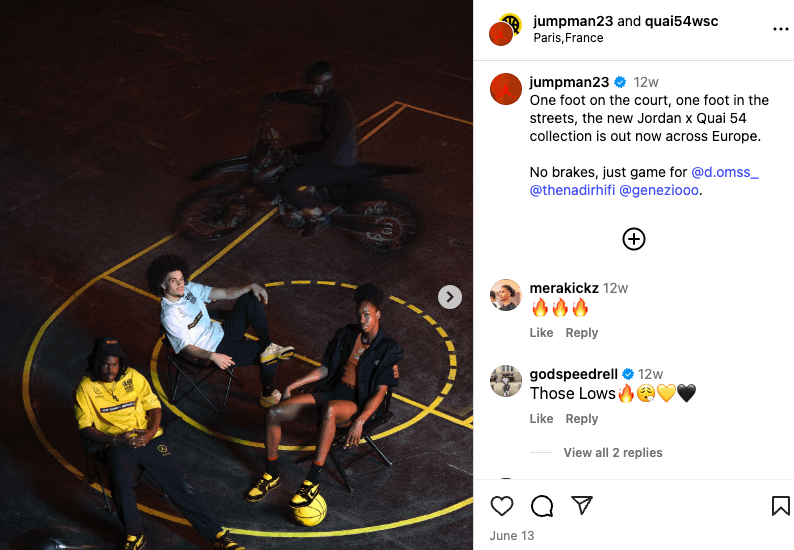
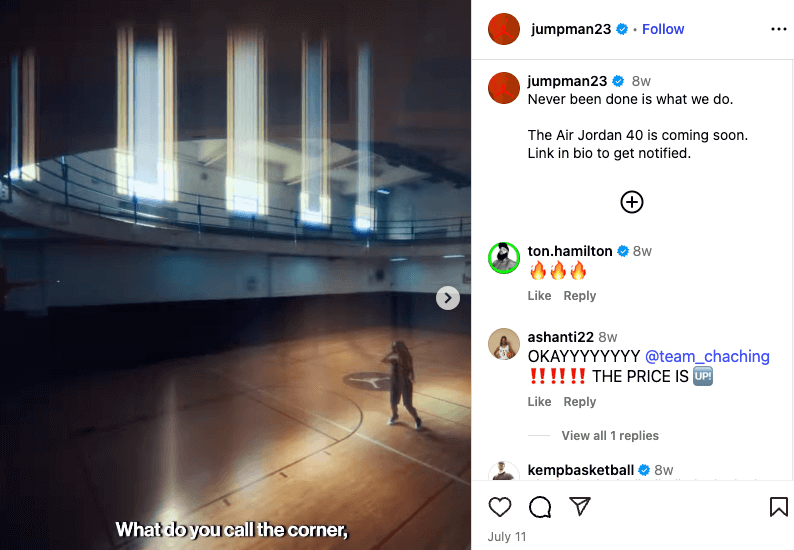

Share